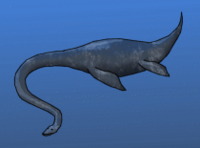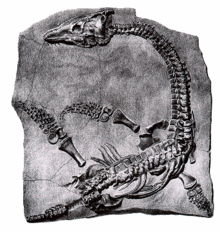|
Plesiosauria |
||||||||||
|---|---|---|---|---|---|---|---|---|---|---|
 |
||||||||||
| Scientific classification | ||||||||||
|
||||||||||
|
Plesiosauroidea Pliosauroidea |
Plesiosauria (IPA /ˈplisiəˌsɔɹ/) (Greek: plesios meaning 'near to' and sauros meaning 'lizard') are an order of Mesozoic marine reptiles. They first appeared in the middle Triassic Period and became especially common during the Jurassic Period, thriving until the K-T extinction at the end of the Cretaceous Period.
The name "plesiosaur" is variously used to refer both to the Order Plesiosauria as a whole, and to the long-necked forms (Suborder Plesiosauroidea) only. These latter constitute the plesiosaurs in the popular imagination ("Nessie"). In the current page, "Plesiosaur" is used to refer to the Plesiosauria in general.
Contents |
Description
The typical plesiosaur had a broad body and a short tail. They retained their ancestral two pairs of limbs, which evolved into large flippers. Plesiosaurs evolved from the earlier nothosaurs, who had a more crocodile-like body; major types of plesiosaur are primarily distinguished by head and neck size. The Plesiosauroidea such as Cryptoclididae, Elasmosauridae and Plesiosauridae had long necks and may have been 'bottom-feeders', in shallow waters. The Pliosauridae (Pliosaurs), however, had a short neck with large, elongated head and may have been at home in deeper waters.
All plesiosaurs had four paddle-shaped 'flipper' limbs. This is an unusual arrangement in aquatic animals and it is thought that they were used to propel the animal through the water by a combination of rowing movements and up-and-down movements. There appears to have been no tail fin and the tail was most likely used for helping in directional control. This arrangement is in contrast to that of the later mosasaurs and the earlier ichthyosaurs. There may be similarities with the method of swimming used by penguins and turtles, which respectively have two and four flipper-like limbs.
As a group, the plesiosaurs were the largest aquatic animals of their time, and even the smallest were about 2 m (6.5 ft) long. They grew to be considerably larger than the largest giant crocodiles, and were bigger than their successors, the mosasaurs. However, their predecessors as rulers of the sea, the dolphin-like ichthyosaurs, are known to have reached 23 m in length, and the modern whale shark (18 m), sperm whale (20 m), and especially the blue whale (30 m) are known from considerably larger specimens.
The anteriorly placed internal nostrils have palatal grooves to channel water, the flow of which would be maintained by hydrodynamic pressure over the posteriorly placed external nares during locomotion. During its passage through the nasal ducts, the water would have been 'tasted' by olfactory epithelia.

History of discovery
Mary Anning (1799 - 1847) was famous for her Plesiosaur discoveries at Lyme Regis in Dorset, UK. She is credited with the first Plesiosaur find (Plesiosaurus dolichodeirus), which has become the 'type fossil' (genoholotype). This region of Britain is now a World Heritage Site, dubbed the Jurassic Coast.
Behaviour
Plesiosaurs have been discovered with fossils of belemnites (squid-like animals), and ammonites (giant nautilus-like molluscs) associated with their stomachs. They had powerful jaws, probably strong enough to bite through the hard shells of their prey. The bony fish (Osteichthyes), started to spread in the Jurassic, and were likely prey as well. Recent evidence seems to indicate that some plesiosaurs may have, in fact, been bottom feeders.[1]
It had been theorized that smaller plesiosaurs may have crawled up on a beach to lay their eggs, like the modern leatherback turtle, but it is now clear plesiosaurs gave birth to live young.
Another curiosity is their four-flippered design. No modern animals have this swimming adaptation, so there is considerable speculation about what kind of stroke they used. While the short-necked pliosaurs (e.g. Liopleurodon) may have been fast swimmers, the long-necked varieties were built more for maneuverability than for speed. Skeletons have also been discovered with gastroliths in their stomachs, though whether to help break down food in a muscular gizzard, or to help with buoyancy has not been established (Everhart).
Taxonomy
The classification of the Plesiosauria has varied over time; the following represents one current version (mostly following O'Keefe 2001)
- Superorder
SAUROPTERYGIA
- Order PLESIOSAURIA
- Suborder
Pliosauroidea
- Thalassiodracon
Attenborosaurus
Eurycleidus
Family Rhomaleosauridae
Family Pliosauridae
- Thalassiodracon
- Suborder
Plesiosauroidea
- Family Plesiosauridae
- (Unranked)
Euplesiosauria
- Family Elasmosauridae
- Superfamily Cryptoclidoidea
- Family Cryptoclididae
- (Unranked)
Tricleidia
- Tricleidus
- Family Cimoliasauridae
- Family Polycotylidae (= "Dolichorhynchopidae")
- Suborder
Pliosauroidea
- Order PLESIOSAURIA
Recent discoveries
In 2002, the "Monster of Aramberri" was announced to the press. Discovered in 1982 at the village of Aramberri, in the Mexican state of Nuevo León, it was originally classified as a dinosaur. The specimen is actually a very large plesiosaur, possibly reaching 15 m (50 ft) in length. The media published exaggerated reports claiming it was 25 m (80 ft) long, and weighed up to 150,000 kg, which would have made it the largest predator of all time. This error was dramatically perpetuated in BBC's documentary series Walking with Dinosaurs, which also prematurely classified it as a Liopleurodon ferox.
In 2004, what appears to be a completely intact juvenile plesiosaur was discovered, by a local fisherman at Bridgwater Bay National Nature Reserve in Somerset, UK. The fossil, dated 180 My by the ammonites associated with it, measures 1.5 m (5 ft) in length, and may be related to Rhomaleosaurus. It is probably the best preserved specimen of a plesiosaur yet discovered (see Ref.)
See also
External links
- The Plesiosaur Site. Richard Forrest.
-
The Plesiosaur Directory. Adam Stuart Smith.
- Plesiosauria technical definition at the Plesiosaur Directory
- Plesiosaur FAQ's. Raymond Thaddeus C. Ancog.
- Oceans of Kansas Paleontology. Mike Everhart.
- "Plesiosaur fossil found in Bridgwater Bay". Somersert Museums County Service. (best known fossil)
- "Fossil hunters turn up 50-ton monster of prehistoric deep". Allan Hall and Mark Henderson. Times Online, December 30, 2002. (Monster of Aramberri)
- Triassic reptiles had live young.
- Bridgwater Bay juvenile plesiosaur
References
- Lingham-Soliar, T., 1995: in Phil. Trans. Roy. Soc. Lond. 347: 155-180
- Cicimurri, D., and M. Everhart, 2001: in Trans. Kansas. Acad. Sci. 104: 129-143
- O'Keefe, F. R., 2001: A cladistic analysis and taxonomic revision of the Plesiosauria (Reptilia: Sauropterygia); Acta Zool. Fennica 213: 1-63
- White, T., 1935: in Occasional Papers Boston Soc. Nat. Hist. 8: 219-228
- Hampe, O., 1992: Courier Forsch.-Inst. Senckenberg 145: 1-32
- Ellis, R. 2003: Sea Dragons' (Kansas University Press)
- ( ), 1997: in Reports of the National Center for Science Education, 17.3 (May/June 1997) pp 16–28.
- Everhart, M.J. 2005. "Where the Elasmosaurs roamed," Chapter 7 in "Oceans of Kansas: A Natural History of the Western Interior Sea," Indiana University Press, Bloomington, 322 p.
- Everhart, M.J. 2005. "Gastroliths associated with plesiosaur remains in the Sharon Springs Member (Late Cretaceous) of the Pierre Shale, Western Kansas" (on-line, updated from article in Kansas Acad. Sci. Trans. 103(1-2):58-69)